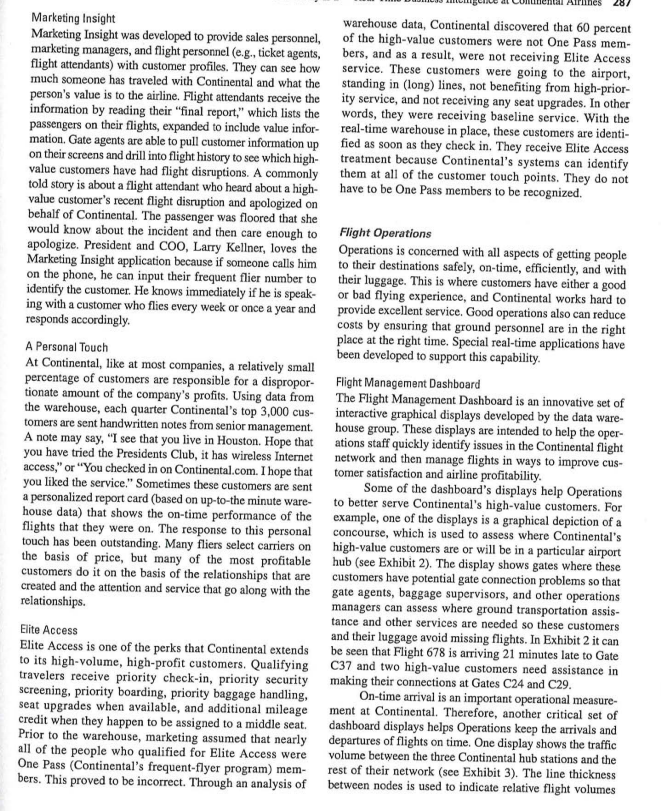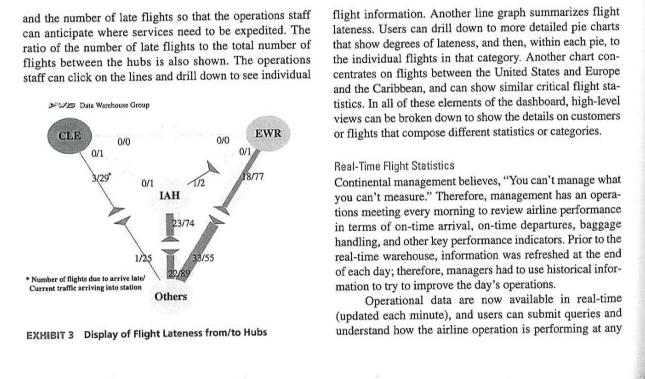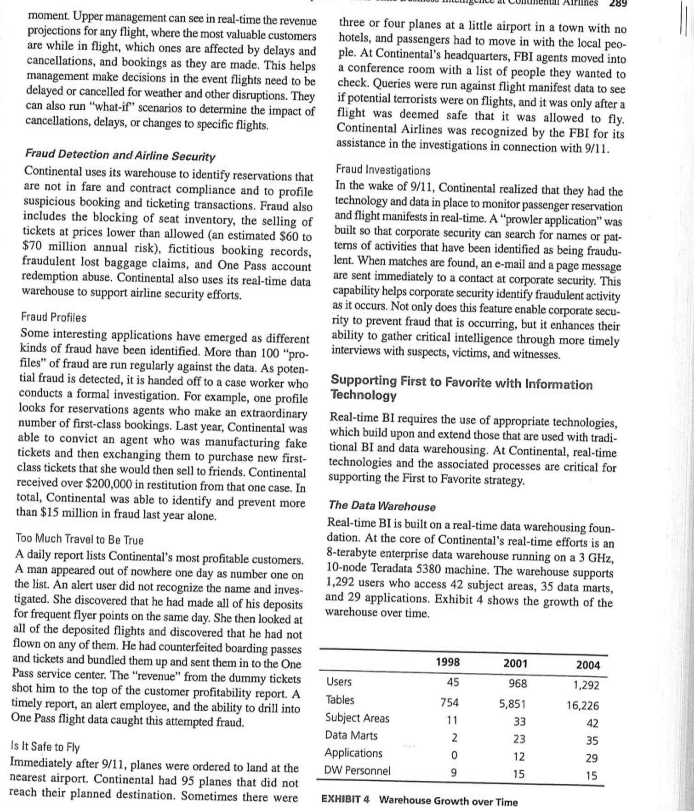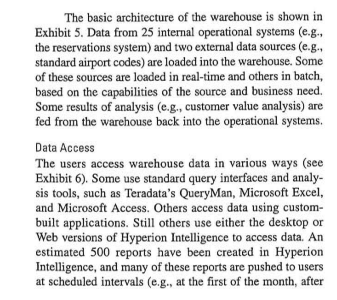Transcribe the Text




and the number of late flights so that the operations staff can anticipate where services need to be expedited. The ratio of the number of late flights to the total number of flights between the hubs is also shown. The operations staff can click on the lines and drill down to see individual flight information. Another line graph summarizes flight lateness. Users can drill down to more detailed pie charts that show degrees of lateness, and then, within each pie, to the individual flights in that category. Another chart concentrates on flights between the United States and Europe and the Caribbean, and can show similar critical flight statistics. In all of these elements of the dashboard, high-level views can be broken down to show the details on customers or flights that compose different statistics or categories. Real-Time Flight Statistics Continental management believes, "You can't manage what you can't measure." Therefore, management has an operations meeting every morning to review airline performance in terms of on-time arrival, on-time departures, baggage handling, and other key performance indicators. Prior to the real-time warehouse, information was refreshed at the end of each day; therefore, managers had to use historical information to try to improve the day's operations. Operational data are now available in real-time (updated each minute), and users can submit queries and understand how the airline operation is performing at any EXHIBIT 3 Display of Flight Lateness from/to Hubs The basic architecture of the warehouse is shown in Exhibit 5. Data from 25 internal operational systems (e.g., the reservations system) and two external data sources (e.g., standard airport codes) are loaded into the warehouse. Some of these sources are loaded in real-time and others in batch, based on the capabilities of the source and business need. Some results of analysis (e.g., customer value analysis) are fed from the warehouse back into the operational systems. Data Access The users access warehouse data in various ways (see Exhibit 6). Some use standard query interfaces and analysis tools, such as Teradata's QueryMan, Microsoft Excel, and Microsoft Access. Others access data using custombuilt applications. Still others use either the desktop or Web versions of Hyperion Intelligence to access data. An estimated 500 reports have been created in Hyperion Intelligence, and many of these reports are pushed to users at scheduled intervals (e.g., at the first of the month, after moment. Upper management can see in real-time the revenue projections for any flight, where the most valuable customers are while in flight, which ones are affected by delays and cancellations, and bookings as they are made. This helps management make decisions in the event flights need to be delayed or cancelled for weather and other disruptions. They can also run "what-if" scenarios to determine the impact of cancellations, delays, or changes to specific flights. Fraud Detection and Airline Security Continental uses its warehouse to identify reservations that are not in fare and contract compliance and to profile suspicious booking and ticketing transactions. Fraud also includes the blocking of seat inventory, the selling of tickets at prices lower than allowed (an estimated $60 to $70 million annual risk), fictitious booking records, fraudulent lost baggage claims, and One Pass account redemption abuse. Continental also uses its real-time data warehouse to support airline security efforts. Fraud Profiles Some interesting applications have emerged as different kinds of fraud have been identified. More than 100 "profiles" of fraud are run regularly against the data. As potential fraud is detected, it is handed off to a case worker who conducts a formal investigation. For example, one profile looks for reservations agents who make an extraordinary number of first-class bookings. Last year, Continental was able to convict an agent who was manufacturing fake tickets and then exchanging them to purchase new firstclass tickets that she would then sell to friends. Continental received over $200,000 in restitution from that one case. In total, Continental was able to identify and prevent more than $15 million in fraud last year alone. Too Much Travel to Be True A daily report lists Continental's most profitable customers. A man appeared out of nowhere one day as number one on the list. An alert user did not recognize the name and investigated. She discovered that he had made all of his deposits for frequent flyer points on the same day. She then looked at all of the deposited flights and discovered that he had not flown on any of them. He had counterfeited boarding passes and tickets and bundled them up and sent them in to the One Pass service center. The "revenue" from the dummy tickets shot him to the top of the customer profitability report. A timely report, an alert employee, and the ability to drill into One Pass flight data caught this attempted fraud. Is It Safe to Fly Immediately after 9/11, planes were ordered to land at the nearest airport. Continental had 95 planes that did not reach their planned destination. Sometimes there were three or four planes at a little airport in a town with no hotels, and passengers had to move in with the local people. At Continental's headquarters, FBI agents moved into a conference room with a list of people they wanted to check. Queries were run against flight manifest data to see if potential terrorists were on flights, and it was only after a flight was deemed safe that it was allowed to fly. Continental Airlines was recognized by the FBI for its assistance in the investigations in connection with 9/11. Fraud Investigations In the wake of 9/11, Continental realized that they had the technology and data in place to monitor passenger reservation and flight manifests in real-time. A "prowler application" was built so that corporate security can search for names or pattems of activities that have been identified as being fraudulent. When matches are found, an e-mail and a page message are sent immediately to a contact at corporate security. This capability helps corporate security identify fraudulent activity as it occurs. Not only does this feature enable corporate security to prevent fraud that is occurring, but it enhances their ability to gather critical intelligence through more timely interviews with suspects, victims, and witnesses. Supporting First to Favorite with Information Technology Real-time BI requires the use of appropriate technologies, which build upon and extend those that are used with traditional BI and data warehousing. At Continental, real-time technologies and the associated processes are critical for supporting the First to Favorite strategy. The Data Warehouse Real-time BI is built on a real-time data warehousing foundation. At the core of Continental's real-time efforts is an 8-terabyte enterprise data warehouse running on a 3GHz, 10 -node Teradata 5380 machine. The warehouse supports 1,292 users who access 42 subject areas, 35 data marts, and 29 applications. Exhibit 4 shows the growth of the warehouse over time. EXHIBIT 4 Warehouse Growth over Time Marketing Insight Marketing Insight was developed to provide sales personnel, marketing managers, and flight personnel (e.g., ticket agents, flight attendants) with customer profiles. They can see how much someone has traveled with Continental and what the person's value is to the airline. Flight attendants receive the information by reading their "final report," which lists the passengers on their flights, expanded to include value information. Gate agents are able to pull customer information up on their screens and drill into flight history to see which highvalue customers have had flight disruptions. A commonly told story is about a flight attendant who heard about a highvalue customer's recent flight disruption and apologized on behalf of Continental. The passenger was floored that she would know about the incident and then care enough to apologize. President and COO, Larry Kellner, loves the Marketing Insight application because if someone calls him on the phone, he can input their frequent flier number to identify the customer. He knows immediately if he is speaking with a customer who flies every week or once a year and responds accordingly. A Personal Touch At Continental, like at most companies, a relatively small percentage of customers are responsible for a disproportionate amount of the company's profits. Using data from the warehouse, each quarter Continental's top 3,000 customers are sent handwritten notes from senior management. A note may say, "I see that you live in Houston. Hope that you have tried the Presidents Club, it has wireless Internet access," or "You checked in on Continental.com. I hope that you liked the service." Sometimes these customers are sent a personalized report card (based on up-to-the minute warehouse data) that shows the on-time performance of the flights that they were on. The response to this personal touch has been outstanding. Many fliers select carriers on the basis of price, but many of the most profitable customers do it on the basis of the relationships that are created and the attention and service that go along with the relationships. Elite Access Elite Access is one of the perks that Continental extends to its high-volume, high-profit customers. Qualifying travelers receive priority check-in, priority security screening, priority boarding, priority baggage handling, seat upgrades when available, and additional mileage credit when they happen to be assigned to a middle seat. Prior to the warehouse, marketing assumed that nearly all of the people who qualified for Elite Access were One Pass (Continental's frequent-flyer program) members. This proved to be incorrect. Through an analysis of warehouse data, Continental discovered that 60 percent of the high-value customers were not One Pass members, and as a result, were not receiving Elite Access service. These customers were going to the airport, standing in (long) lines, not benefiting from high-priority service, and not receiving any seat upgrades. In other words, they were receiving baseline service. With the real-time warehouse in place, these customers are identified as soon as they check in. They receive Elite Access treatment because Continental's systems can identify them at all of the customer touch points. They do not have to be One Pass members to be recognized. Flight Operations Operations is concerned with all aspects of getting people to their destinations safely, on-time, efficiently, and with their luggage. This is where customers have either a good or bad flying experience, and Continental works hard to provide excellent service. Good operations also can reduce costs by ensuring that ground personnel are in the right place at the right time. Special real-time applications have been developed to support this capability. Flight Management Dashboard The Flight Management Dashboard is an innovative set of interactive graphical displays developed by the data warehouse group. These displays are intended to help the operations staff quickly identify issues in the Continental flight network and then manage flights in ways to improve customer satisfaction and airline profitability. Some of the dashboard's displays help Operations to better serve Continental's high-value customers. For example, one of the displays is a graphical depiction of a concourse, which is used to assess where Continental's high-value customers are or will be in a particular airport hub (see Exhibit 2). The display shows gates where these customers have potential gate connection problems so that gate agents, baggage supervisors, and other operations managers can assess where ground transportation assistance and other services are needed so these customers and their luggage avoid missing flights. In Exhibit 2 it can be seen that Flight 678 is arriving 21 minutes late to Gate C37 and two high-value customers need assistance in making their connections at Gates C24 and C29. On-time arrival is an important operational measurement at Continental. Therefore, another critical set of dashboard displays helps Operations keep the arrivals and departures of flights on time. One display shows the traffic volume between the three Continental hub stations and the rest of their network (see Exhibit 3). The line thickness between nodes is used to indicate relative flight volumes moment. Upper management can see in real-time the revenue projections for any flight, where the most valuable customers are while in flight, which ones are affected by delays and cancellations, and bookings as they are made. This helps management make decisions in the event flights need to be delayed or cancelled for weather and other disruptions. They can also run "what-if" scenarios to determine the impact of cancellations, delays, or changes to specific flights. Fraud Detection and Airline Security Continental uses its warehouse to identify reservations that are not in fare and contract compliance and to profile suspicious booking and ticketing transactions. Fraud also includes the blocking of seat inventory, the selling of tickets at prices lower than allowed (an estimated $60 to $70 million annual risk), fictitious booking records, fraudulent lost baggage claims, and One Pass account redemption abuse. Continental also uses its real-time data warehouse to support airline security efforts. Fraud Profiles Some interesting applications have emerged as different kinds of fraud have been identified. More than 100 "profiles" of fraud are run regularly against the data. As potential fraud is detected, it is handed off to a case worker who conducts a formal investigation. For example, one profile looks for reservations agents who make an extraordinary number of first-class bookings. Last year, Continental was able to convict an agent who was manufacturing fake tickets and then exchanging them to purchase new firstclass tickets that she would then sell to friends. Continental received over $200,000 in restitution from that one case. In total, Continental was able to identify and prevent more than $15 million in fraud last year alone. Too Much Travel to Be True A daily report lists Continental's most profitable customers. A man appeared out of nowhere one day as number one on the list. An alert user did not recognize the name and investigated. She discovered that he had made all of his deposits for frequent flyer points on the same day. She then looked at all of the deposited flights and discovered that he had not flown on any of them. He had counterfeited boarding passes and tickets and bundled them up and sent them in to the One Pass service center. The "revenue" from the dummy tickets shot him to the top of the customer profitability report. A timely report, an alert employee, and the ability to drill into One Pass flight data caught this attempted fraud. Is It Safe to Fly Immediately after 9/11, planes were ordered to land at the nearest airport. Continental had 95 planes that did not reach their planned destination. Sometimes there were three or four planes at a little airport in a town with no hotels, and passengers had to move in with the local people. At Continental's headquarters, FBI agents moved into a conference room with a list of people they wanted to check. Queries were run against flight manifest data to see if potential terrorists were on flights, and it was only after a flight was deemed safe that it was allowed to fly. Continental Airlines was recognized by the FBI for its assistance in the investigations in connection with 9/11. Fraud Investigations In the wake of 9/11, Continental realized that they had the technology and data in place to monitor passenger reservation and flight manifests in real-time. A "prowler application" was built so that corporate security can search for names or pattems of activities that have been identified as being fraudulent. When matches are found, an e-mail and a page message are sent immediately to a contact at corporate security. This capability helps corporate security identify fraudulent activity as it occurs. Not only does this feature enable corporate security to prevent fraud that is occurring, but it enhances their ability to gather critical intelligence through more timely interviews with suspects, victims, and witnesses. Supporting First to Favorite with Information Technology Real-time BI requires the use of appropriate technologies, which build upon and extend those that are used with traditional BI and data warehousing. At Continental, real-time technologies and the associated processes are critical for supporting the First to Favorite strategy. The Data Warehouse Real-time BI is built on a real-time data warehousing foundation. At the core of Continental's real-time efforts is an 8-terabyte enterprise data warehouse running on a 3GHz, 10 -node Teradata 5380 machine. The warehouse supports 1,292 users who access 42 subject areas, 35 data marts, and 29 applications. Exhibit 4 shows the growth of the warehouse over time. EXHIBIT 4 Warehouse Growth over Time The basic architecture of the warehouse is shown in Exhibit 5. Data from 25 internal operational systems (e.g., the reservations system) and two external data sources (e.g., standard airport codes) are loaded into the warehouse. Some of these sources are loaded in real-time and others in batch, based on the capabilities of the source and business need. Some results of analysis (e.g., customer value analysis) are fed from the warehouse back into the operational systems. Data Access The users access warehouse data in various ways (see Exhibit 6). Some use standard query interfaces and analysis tools, such as Teradata's QueryMan, Microsoft Excel, and Microsoft Access. Others access data using custombuilt applications. Still others use either the desktop or Web versions of Hyperion Intelligence to access data. An estimated 500 reports have been created in Hyperion Intelligence, and many of these reports are pushed to users at scheduled intervals (e.g., at the first of the month, after Marketing Insight Marketing Insight was developed to provide sales personnel, marketing managers, and flight personnel (e.g., ticket agents, flight attendants) with customer profiles. They can see how much someone has traveled with Continental and what the person's value is to the airline. Flight attendants receive the information by reading their "final report," which lists the passengers on their flights, expanded to include value information. Gate agents are able to pull customer information up on their screens and drill into flight history to see which highvalue customers have had flight disruptions. A commonly told story is about a flight attendant who heard about a highvalue customer's recent flight disruption and apologized on behalf of Continental. The passenger was floored that she would know about the incident and then care enough to apologize. President and COO, Larry Kellner, loves the Marketing Insight application because if someone calls him on the phone, he can input their frequent flier number to identify the customer. He knows immediately if he is speaking with a customer who flies every week or once a year and responds accordingly. A Personal Touch At Continental, like at most companies, a relatively small percentage of customers are responsible for a disproportionate amount of the company's profits. Using data from the warehouse, each quarter Continental's top 3,000 customers are sent handwritten notes from senior management. A note may say, "I see that you live in Houston. Hope that you have tried the Presidents Club, it has wireless Internet access," or "You checked in on Continental.com. I hope that you liked the service." Sometimes these customers are sent a personalized report card (based on up-to-the minute warehouse data) that shows the on-time performance of the flights that they were on. The response to this personal touch has been outstanding. Many fliers select carriers on the basis of price, but many of the most profitable customers do it on the basis of the relationships that are created and the attention and service that go along with the relationships. Elite Access Elite Access is one of the perks that Continental extends to its high-volume, high-profit customers. Qualifying travelers receive priority check-in, priority security screening, priority boarding, priority baggage handling, seat upgrades when available, and additional mileage credit when they happen to be assigned to a middle seat. Prior to the warehouse, marketing assumed that nearly all of the people who qualified for Elite Access were One Pass (Continental's frequent-flyer program) members. This proved to be incorrect. Through an analysis of warehouse data, Continental discovered that 60 percent of the high-value customers were not One Pass members, and as a result, were not receiving Elite Access service. These customers were going to the airport, standing in (long) lines, not benefiting from high-priority service, and not receiving any seat upgrades. In other words, they were receiving baseline service. With the real-time warehouse in place, these customers are identified as soon as they check in. They receive Elite Access treatment because Continental's systems can identify them at all of the customer touch points. They do not have to be One Pass members to be recognized. Flight Operations Operations is concerned with all aspects of getting people to their destinations safely, on-time, efficiently, and with their luggage. This is where customers have either a good or bad flying experience, and Continental works hard to provide excellent service. Good operations also can reduce costs by ensuring that ground personnel are in the right place at the right time. Special real-time applications have been developed to support this capability. Flight Management Dashboard The Flight Management Dashboard is an innovative set of interactive graphical displays developed by the data warehouse group. These displays are intended to help the operations staff quickly identify issues in the Continental flight network and then manage flights in ways to improve customer satisfaction and airline profitability. Some of the dashboard's displays help Operations to better serve Continental's high-value customers. For example, one of the displays is a graphical depiction of a concourse, which is used to assess where Continental's high-value customers are or will be in a particular airport hub (see Exhibit 2). The display shows gates where these customers have potential gate connection problems so that gate agents, baggage supervisors, and other operations managers can assess where ground transportation assistance and other services are needed so these customers and their luggage avoid missing flights. In Exhibit 2 it can be seen that Flight 678 is arriving 21 minutes late to Gate C37 and two high-value customers need assistance in making their connections at Gates C24 and C29. On-time arrival is an important operational measurement at Continental. Therefore, another critical set of dashboard displays helps Operations keep the arrivals and departures of flights on time. One display shows the traffic volume between the three Continental hub stations and the rest of their network (see Exhibit 3). The line thickness between nodes is used to indicate relative flight volumes and the number of late flights so that the operations staff can anticipate where services need to be expedited. The ratio of the number of late flights to the total number of flights between the hubs is also shown. The operations staff can click on the lines and drill down to see individual flight information. Another line graph summarizes flight lateness. Users can drill down to more detailed pie charts that show degrees of lateness, and then, within each pie, to the individual flights in that category. Another chart concentrates on flights between the United States and Europe and the Caribbean, and can show similar critical flight statistics. In all of these elements of the dashboard, high-level views can be broken down to show the details on customers or flights that compose different statistics or categories. Real-Time Flight Statistics Continental management believes, "You can't manage what you can't measure." Therefore, management has an operations meeting every morning to review airline performance in terms of on-time arrival, on-time departures, baggage handling, and other key performance indicators. Prior to the real-time warehouse, information was refreshed at the end of each day; therefore, managers had to use historical information to try to improve the day's operations. Operational data are now available in real-time (updated each minute), and users can submit queries and understand how the airline operation is performing at any EXHIBIT 3 Display of Flight Lateness from/to Hubs










